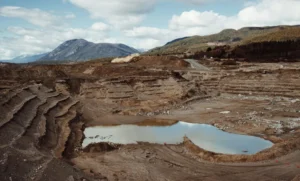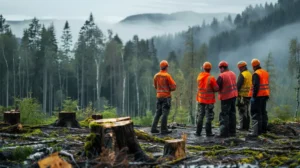It will be like waking up in a world where extreme weather events are occurring more and more frequently, with every other week being a case of wildfires, floods, and heatwaves. No, this is not the future expectation but it’s our reality today.
Climate change is no longer something we can ignore because its impacts are felt across the world.
In this article, we will take a closer look at what climate change is, why it’s happening, and how it affects our everyday lives. No matter whether you have recently listened to news about it or noticed changes in the way your weather patterns are these days. Climate change is altering our world, and understanding what is going on is important.
What is Climate Change

Climate change can be defined as any long-term change in the climate patterns of the Earth system. This process has mainly been caused by a higher concentration of greenhouse gasses including carbon dioxide and methane that accumulate in the atmosphere to trap more solar radiation at the surface.
For instance, these changes have resulted in different things, from increased sea levels to increased hurricanes, droughts, and heat waves that occur frequently. The rain patterns change, and so does the habitat of plants and animals.
The Basics of Climate Change
Climate change refers to changes in Earth’s climate over long periods, such as rising temperature, change in rainfall patterns, and wind system. Within the last century, global temperatures have generally risen by a significant amount. This rise contributes to global warming, which is one of the most obvious signs of changing in the climate system.
Global warming impacts the environment as well as ecosystems, biodiversity, and human settlements.
The Earth has been experiencing natural changes in climate over millions of years. However, such changes are occurring at an odd rate due to human activities. Burning fossil fuels, such as coal, oil, and gas, contributes to greenhouse gasses in the atmosphere. These gasses trap heat and affect the global temperature and alter weather patterns.
Causes of Climate Change

The most severe cause of climate change has been the human factor. However, it is not the only cause.
- Burning Fossil Fuels
Every time we use our car, take an airplane ride or use electricity derived from coal or natural gas, then carbon dioxide (CO2) enters the air. The accumulation of that gas with methane and nitrous oxide traps heat and warms the Earth. - Deforestation
The trees absorb CO2; therefore, they help control the climate. However, large-scale deforestation, especially in the Amazon rainforest has lowered the ability of the Earth to soak up carbon emissions. This has accelerated the further process of global warming. - Industrial Processes and Agriculture
Most industrial processes release massive amounts of greenhouse gasses. Agriculture contributes to climate change also because methane is released through livestock farming. Promotion of sustainable agriculture practices is very essential for environmental protection. - Air Pollution
Air pollution aggravates climate change because the emission of these greenhouse gasses such as carbon dioxide, methane, and others like CFCs contributes to global warming and the production of smog.
Even though natural causes such as eruptions of volcanoes or variations in the sun have an impact on climate, significant evidence suggests that human activities have been causing recent changes.
Global Effects of Climate Change
The effects of global warming have far reaching implications and appear disturbingly alarming. Global temperatures have been rising, causing polar ice caps and melting of glaciers, adding to the rise of sea levels, and hence coastal areas become susceptible to flooding.
Here are some major effects:
- Rising Temperatures:
Average temperature has increased approximately 1.1 degrees Celsius since the late nineteenth century. Although this doesn’t seem like much, tiny rises can cause extreme weather, including deadly heat waves. - Severe Weather Patterns:
Climate change results in stronger storms, hurricanes, and floods. Warm oceans provide a stronger storm whereas the changing of wind pattern is disturbing rainfall causing droughts in some areas and heavy rainfall in others. - Ecosystem Disruption:
Many animals and plants are failing to cope with the climatic changes. Species that rely only on certain temperature ranges or habitats face extinction. There is widespread bleaching on coral reefs due to warmer ocean temperatures.
These effects can already be seen: from devastating the east coast of Australia with wildfires to flooding coastal cities. The long-term impacts could be much worse and catastrophic for vulnerable populations and ecosystems.
Future Impacts and Solutions
If we do not alter the way of life as it exists, then it will have more changes in the future. Scientists say that if the temperatures of Earth rise above 1.5°C to 2°C, then it may become dangerous and cannot be controlled further.
So what is being done to reduce the increased rate of climate change? Well, here’s good news-the solutions are already available:
- Switching to Renewable Energy:
The generation of solar, wind, and hydroelectric power avoids burning up fossil fuel and also reduces greenhouse emissions by a larger margin. - Reforestation Efforts:
Increasing more trees is going to absorb some CO2 and restore ecosystems that had been destroyed with deforestation. Such restoration efforts are key to environmental protection, as they restore biodiversity and enhance the planet’s ability to combat climate crisis. - Reducing Waste and Pollution:
Reducing plastic uses, recycling more, and also consuming fewer products that are directly associated with emitting CO2 can make a difference.
All the governments of the world have been taking measures in this regard. However, personal actions matter just as much. Small changes, such as using energy-efficient appliances or cutting car use, can add up over time.
Conclusion
Climate change is one of the greatest challenges of our time. Human activity has created an incredible rate of changing our planet’s climate and it has been experienced throughout the world. Rising temperature and natural disasters that often take place are signs of climate change.
While the future remains unclear, there is a hope beyond. Taking steps to reduce our impact and supporting efforts globally toward fighting climate change can help slow its effects and protect our planet and biodiversity.
The most important step for a greener tomorrow would be the recognition of environmental protection in the light of the climate crisis. This could be done by supporting international initiatives and following environmentally friendly practices that ensure a future of livable life for coming generations.




